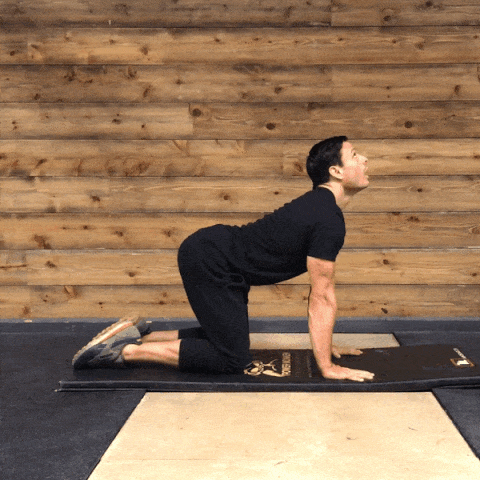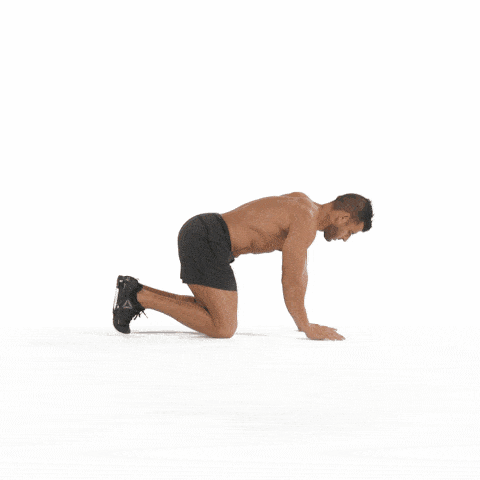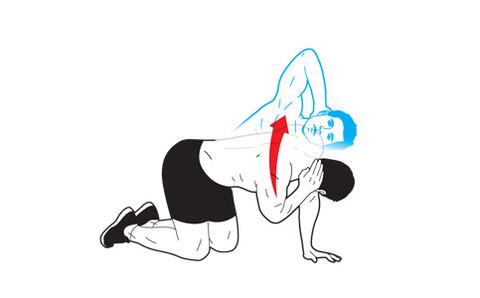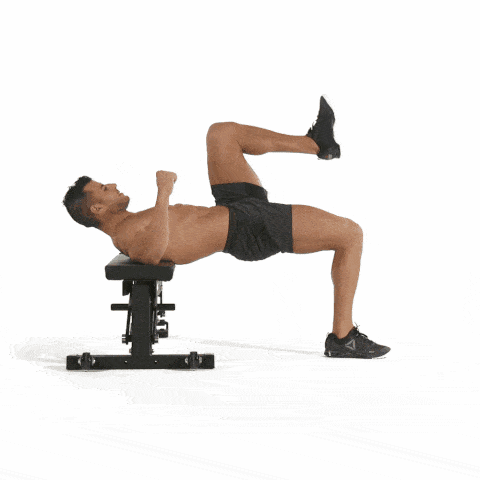12 Exercises That Help Fix Your Crappy Posture

Life as an office drone might be good for your bank account — but your cushy job is not great for your body.
Work out all you want on your own time, but if you spend all day sitting at a desk, you’re bound to develop some poor posture habits. Add in the constant attention we give to our smartphones, and your neck, shoulders, and back are likely to be in even rougher shape
Now, experts say we have to worry about “text neck,” a plethora of problems that come from being hunched over your phone all day. “Your neck is forward, your shoulders are slouching, there’s more rounding of the upper back, and you’re closing up your body,” says Noam Tamir, C.S.C.S., owner and founder of TS Fitness, a strength and conditioning studio in New York City.
Not only does that give you the posture of Quasimodo, it can also lead to neck pain, wrist mobility issues, and muscular imbalances. And if you jump into a workout in that hunched-over position, you could be setting yourself up for an injury.
“If you bust out bench presses, you’re tightening pecs that are already tight,” Tamir says. Plus, if your shoulders are rounded forward, it can make it harder to press overhead, and if you force it, that can lead to bone spurs, tendinitis, or torn tendons.
In addition to the risk of injury, all these tight muscles can inhibit your strength gains. “Adequate range of motion around the joints is imperative to perform loaded movement patterns safely and effectively,” says Jessica Matthews, master trainer for the American Council on Exercise and author of Stretching to Stay Young.
If you try to bang out reps anyway, other muscles may step up to compensate for tighter, weaker ones, causing you to build muscle where you don’t want it. “You might build up your traps and get big muscles in your shoulder, rather than targeting your rhomboids and other muscles in your back,” Tamir says.
Taking a few minutes at the gym and throughout your day can make a big difference in helping you feel better, avoid injuries, and hit your fitness goals.

Getty ImagesPeopleImages
The best thing you can do to alleviate the muscular woes of working at a desk all day is to move more. Take a break every 30 minutes and walk around for about a minute, recommends physical therapist and strength coach Eric Oetter. “Your tissue is like a rubber band. Sitting applies constant tension, and the rubber band stretches out some,” he says. “Standing up hits reset to help counteract some of the negative effects of sitting.”
Then stretch out a few common tight spots: Nod your head up and down and stretch your neck side to side, then do a few shoulder rolls forward and backward as far as you can, Tamir recommends.
Next stretch out your wrists: Interlace your fingers and flip your palms to face away from your body. Raise your arms to shoulder height and extend your elbows, while simultaneously pushing your palms away from your body.
And for your upper back, use this stretch from Oetter: While seated, place both hands on your desk. Straighten your arms and round your back. Gently press your hands into your desk as you try to expand your upper back with your inhales. Exhale and repeat up to five times.
If it helps, set an alarm to remind you to get up and do these exercises every 30 minutes. The more you can do it, the better

Getty ImagesWestend61
Incorporating regular static stretches into your everyday life will help stretch and lengthen muscles that can become tight as a result of excessive cell phone use, Matthews says. So consider adding these stretches to your morning routine after your shower, when your muscles are warmed up.
Reverse Tabletop
Sit with your knees bent, feet flat on the floor, and palms directly behind body with your fingertips pointing toward your butt. Inhale, gently pressing into your hands and feet to lift your butt off the floor, extending your hips toward the ceiling. Exhale and draw your shoulder blades toward each other to open your chest while carefully lowering your head back and tilting your chin up. Hold for 15 to 30 seconds. Repeat until you’ve stretched for a total of 60 seconds.


Men's Health
Get on all fours with your wrists aligned below your shoulders and your knees aligned below your hips. Keep your toes tucked under. Inhale, relaxing your belly so it moves toward the floor, and gently arching your back, tilting your tailbone and chin toward the ceiling. Exhale, gently rounding your spine, drawing your chin to your chest, and untucking your toes. Repeat this movement back and forth for 6 to 10 reps.


Men's Health
From the same all fours position, tuck your right toes under and extend your right leg behind you. Slowly lift your leg off the floor no higher than hip height. Bracing your core, slowly reach your left arm forward no higher than shoulder height and turn your palm inward so your thumb points toward the ceiling. Hold for no more than 7 to 8 seconds, keeping your hips and shoulders level. Return to starting position and repeat on the opposite side. Continue alternating for 6 to 10 reps on each side.

Men's Health
From all fours, sit back onto your heels as in child’s pose. Place one hand behind your head with your elbow pointing toward the floor. Rotate your chest until your elbow points to the ceiling. Lower back to the starting position. Do 6 to 10 reps, then switch sides.

Getty ImagesRidofranz
The best thing you can do to avoid injuries and keep making gains is to warm up properly before every workout. If you typically skip a warmup—who has time?—think about it this way: “If you don’t make the time now, you’ll be forced to make time for injury later,” Tamir says. “Now it’s within your choice to take five minutes and do a warmup; later it won’t be your choice, and you’ll be forced to deal with an injury.”
Try these exercises from Oetter.
Lat Hang
This is great for alleviating the tight lats, pecs, and upper back that result from our typical texting or desk posture. It opens up the shoulder girdle prior to upper-body pushing or pulling movements.
Place a box or bench below a pullup bar. Step onto the box so your feet are shoulder-width apart and slightly in front of you. Keeping your feet on the bench, grasp the bar and let your torso hang so you feel the stretch in your armpits and across your chest. Tuck your pelvis under, inhale through your nose, and slowly exhale through pursed lips. Your ribs should feel like they are moving down as you exhale. Pause 3 seconds, then repeat. Do 2 sets of 6 breaths.
Modified All-Fours Belly Lift
This exercise helps “pop out the dent” that Oetter says is typical in a flattened upper back while also activating your core muscles and key upper-body stabilizers for shoulder health.
Come to all fours and round your spine by arching your back upward and tucking your butt under you. Shift your body weight forward so your nose is over your fingertips. (You should feel your outer abdominals.) From this position, raise your left hand off the floor a few inches without twisting your trunk. (You should feel your right abdominal wall engage.) Hold for 6 deep breaths, focusing on trying to breathe into and stretch your upper back. Lower your left hand and repeat, lifting your right hand off the floor. Do 2 sets of 6 breaths per side.
Groiner With Overhead Reach
This combines many of our targets (hip mobility, ribcage rotation, shoulder mobility, etc.) into a single ground-based movement.
Get in a pushup position. Step your right foot outside your right hand. Drop your left knee down to the ground so you feel a stretch in the front of your left hip. Press your left hand into the ground and reach your right arm toward the sky, rotating through your upper back to open your chest and following your hand with your eyes. Place your right hand back on the ground and return to the starting position. Repeat on the other side. Do 6 reps per side.
All-Fours Belly Lift Walk
This movement helps solidify a healthy arms-overhead position while also adding some inhibitory work for the hamstrings and calves. Come to all fours and round your back. Lift your knees and straighten your legs. Contract your abdominal muscles as you bend your knees and “walk” your feet closer to your hands, taking small steps. (Your hands should not move.) Maintaining the contraction of your abdominals in this position with your back rounded and your heels driving toward the ground, hold the position for 6 deep breaths.
During this exercise, “reach” into the ground to activate the shoulder stabilizers.


Men's Health
This move will active your glutes and hamstrings while simultaneously inhibiting overactive hip flexors.
Lie with your upper back resting on a bench and your feet flat on the floor in front of you. Lift your left foot off the ground, then raise your hips until your body forms a straight line from your shoulders to your knees. At the top of the rep your left thigh should be perpendicular to the floor. Hold for a count and then slowly return to the starting position. Don’t let your left foot touch the ground between reps. Do 8 reps per side.
Follow it all up with some dynamic, movement-specific activities tailored to your workout—like multi-planar lunges, squats, deadlifts, and pushups—and you’re good to go, Oetter says.
Source: Read Full Article
